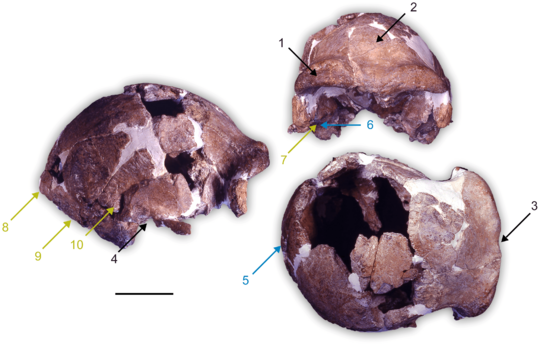Ceprano Man facts for kids
Quick facts for kids Ceprano Man |
|
|---|---|
| Scientific classification | |
| Genus: |
Homo
|
| Species: |
cepranensis
|
Ceprano Man, also known as Argil or the Ceprano Calvarium, is the name given to an ancient human fossil. It's just a single skull cap, which is the top part of a skull. This fossil was found by accident in 1994 during a highway construction project near Ceprano, Italy.
Even though a bulldozer damaged it, an archaeologist named Italo Biddittu was there and recognized its importance. He made sure it was properly recorded and studied. Later, in 2003, some scientists suggested that this fossil belonged to a completely new human species, which they called Homo cepranensis. However, other scientists think it might be a type of Homo heidelbergensis, another ancient human. Some research even suggests it could be an ancestor of H. heidelbergensis or even Homo rhodesiensis.
Contents
How Was Ceprano Man Found?
The Ceprano skull cap was found by chance during road construction. It was damaged by machinery, but its importance was quickly understood. Scientists have studied its unique features to try and figure out where it fits in the human family tree.
The skull has a special mix of features. Some are like older human species, and some are more like later ones. For example, it has a specific shape around the eyes and at the back of the skull. These details help scientists compare it to other ancient human fossils.
How Old is Ceprano Man?
When the fossil was first found, scientists thought it was between 690,000 and 900,000 years old. This age was based on studying the rocks and other things found nearby.
Later, after more research and comparing it to a well-known ancient tool-making site called Fontana Ranuccio (which is about 487,000 years old), scientists updated their estimate. They now believe Ceprano Man is most likely around 450,000 years old. This places it in the middle of a time period known as the Middle Pleistocene, which was a very long time ago!
Where Does Ceprano Man Fit In?
The features of the Ceprano skull seem to be a mix between those of Homo erectus (an even older human species) and later species like Homo heidelbergensis. Homo heidelbergensis lived in Europe long before Neanderthals appeared.
A study from 2011 suggested that Ceprano Man might even be an ancestor of Homo neanderthalensis, which means it could be a very important link in the story of human evolution. It helps scientists understand how different human species developed over hundreds of thousands of years.
Significant Skull Features
Scientists look at many small details on the skull to understand its place in human history. Here are some of the key features they noticed on the Ceprano skull:
- It has an incomplete groove above the eye sockets.
- The forehead bone is not very developed and is shifted towards the middle.
- The area above the eyes is curved inwards in the middle.
- The ear canal is in an intermediate position compared to a bone near the cheek.
Other features are considered more "advanced" or "derived," meaning they are like later human species:
- A straight ridge at the back of the skull.
- A specific curve in a part of the skull near the jaw joint.
Some features are considered more "primitive," meaning they are like earlier human species:
- A crest near the ear points downwards.
- The highest point at the back of the skull lines up with another specific point.
- It has a small bony projection behind the mastoid process.
- A specific ridge on the parietal bone (side of the skull).
These details help scientists compare Ceprano Man to other ancient humans and understand how our ancestors evolved.
See also
 In Spanish: Hombre de Ceprano para niños
In Spanish: Hombre de Ceprano para niños


